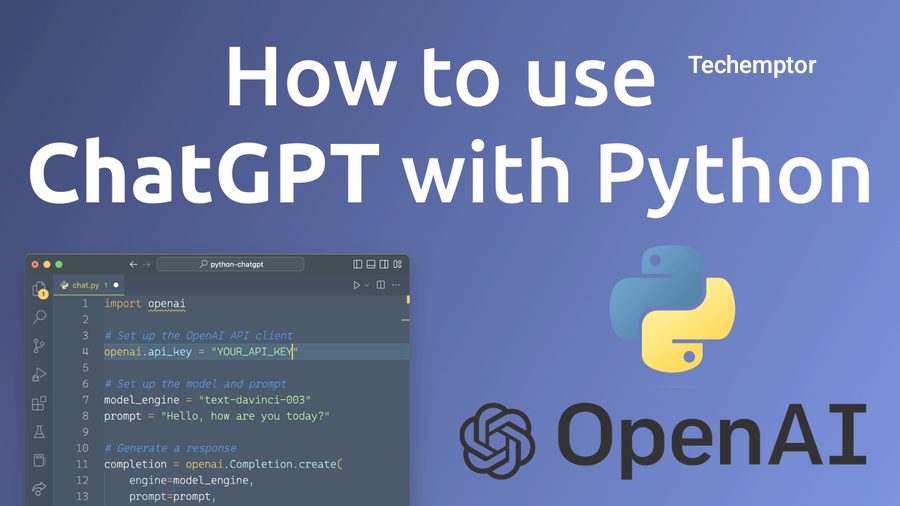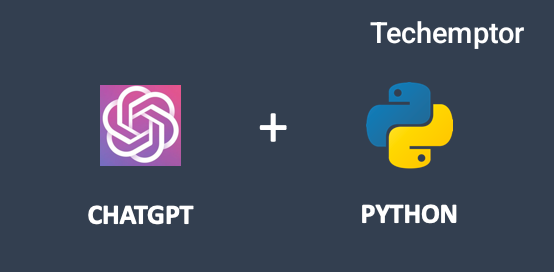
How to Use ChatGPT in Python: The rise of artificial intelligence has revolutionized how we interact with technology. One of the most significant advancements in this domain is the development of conversational AI, and ChatGPT is one of the leading innovations in this space. Developed by OpenAI, ChatGPT is a powerful language model that can understand and generate human-like text based on the input it receives. In this article, we’ll explore how to use ChatGPT in Python, explaining the process in an informative and engaging way for developers and tech enthusiasts.
What is ChatGPT?
Before diving into the details of how to use ChatGPT in Python, it’s important to understand what ChatGPT is. ChatGPT is an AI model based on the GPT-3 (Generative Pretrained Transformer 3) architecture. GPT-3 is a deep learning model trained on vast amounts of text data, enabling it to generate coherent and contextually relevant responses to prompts. ChatGPT specifically focuses on creating conversational responses, making it an excellent tool for chatbots, virtual assistants, and interactive AI applications.
OpenAI provides an API for ChatGPT, which can be integrated into various programming environments, including Python. The flexibility and power of Python make it a popular choice for developers to harness ChatGPT’s capabilities in their projects.
Why Use ChatGPT in Python?
Python is widely recognized for its simplicity, flexibility, and vast libraries that enable smooth integration with AI technologies. When you use ChatGPT in Python, you gain access to several benefits, such as:
- Easy Integration: Python’s seamless syntax and library ecosystem make integrating ChatGPT simple and efficient.
- Extensive Support: Python has a wide range of libraries and tools to support AI projects, including machine learning frameworks like TensorFlow and PyTorch.
- Cross-Platform Usage: Python can be run on multiple platforms, making it ideal for applications where ChatGPT might be deployed on different systems.
- Rapid Development: Python allows for quick prototyping, meaning developers can experiment with ChatGPT and create production-ready applications with minimal effort.
Prerequisites for Using ChatGPT in Python
Before you begin, you’ll need the following:
- Python Environment: Ensure you have Python installed. The recommended version is Python 3.7 or higher.
- OpenAI API Key: To access ChatGPT, you’ll need an API key from OpenAI. You can sign up on their platform and obtain a key after subscribing to their services.
- Basic Knowledge of Python: Familiarity with Python’s basic syntax and operations is essential to make the most out of this guide.
Once you have these ready, you’re all set to learn how to use ChatGPT in Python.

Getting Started with ChatGPT in Python
Step 1: Install Required Libraries
To interact with ChatGPT through Python, you need to install the openai library. This library allows Python to communicate with OpenAI’s API and send requests to ChatGPT.
Step 2: Set Up Your OpenAI API Key
After installation, you’ll need to authenticate your API key with OpenAI. This step is crucial for interacting with the ChatGPT model.
Step 3: Create a ChatGPT Prompt
When using ChatGPT in Python, the key concept is creating a “prompt” that you want the AI to respond to. This prompt can be a simple question or a complex set of instructions.
Step 4: Sending the Request to ChatGPT
After setting up your prompt, you can send it to the ChatGPT model and receive a response. The openai.Completion.create() function sends the prompt to the model and returns the AI-generated text.
Step 5: Handle the Response
Once you receive the response from ChatGPT, you can manipulate it, display it, or use it as part of a larger application. For instance, if you are building a chatbot, the returned response would be the text that gets displayed to the user.
Use Cases of ChatGPT in Python
Understanding how to use ChatGPT in Python opens up a world of possibilities. Here are some of the common use cases where you can integrate ChatGPT:
1. Chatbots
ChatGPT can serve as the core component of a conversational agent, allowing businesses to automate customer support, sales inquiries, and other interactive experiences.
2. Content Generation
ChatGPT can assist in generating human-like text for blog posts, articles, product descriptions, and other forms of content.
3. Language Translation
Although ChatGPT is primarily designed for conversational AI, it can also help with basic translations of languages by providing contextual translations based on a prompt.
4. Interactive Tutors
Many developers are exploring the use of ChatGPT to create interactive educational tools that offer personalized tutoring to students based on the questions or problems they pose.
5. Idea Brainstorming
When working on creative projects or facing writer’s block, ChatGPT can be used to generate ideas or outline concepts that help get the creative process moving.
Best Practices for Using ChatGPT in Python
When learning how to use ChatGPT in Python, it’s essential to follow some best practices to ensure you get the best performance and quality out of the AI model.
1. Create Clear Prompts
The clarity of your prompt plays a significant role in determining the quality of the response. A well-structured and clear prompt is more likely to produce meaningful and accurate responses.
2. Optimize Token Usage
The OpenAI API uses tokens to manage how much content is generated. A single token generally equates to 4 characters of English text. Be mindful of how many tokens you use, especially if you are on a paid plan, as exceeding the token limit can result in additional costs.
3. Handle Errors Gracefully
Always anticipate potential errors, such as timeout issues or miscommunications with the API. Implement appropriate error handling in your code to ensure your program continues to function smoothly.
4. Maintain Ethical Use
As with any AI technology, it’s vital to use ChatGPT ethically. Avoid using it to generate harmful, offensive, or misleading content. Additionally, always make it clear when an AI is generating responses, especially in public-facing applications.
Future of ChatGPT and Python
The future of ChatGPT is incredibly promising. With OpenAI continually improving its models, the integration of ChatGPT in Python will become even more seamless and powerful. As AI continues to evolve, developers will have access to more advanced features, enabling more innovative use cases such as real-time communication, intelligent automation, and enhanced personalization.
Conclusion
In conclusion, understanding how to use ChatGPT in Python provides developers with the ability to create interactive, intelligent, and highly personalized applications. Whether you’re building a chatbot, generating content, or integrating AI into your project, ChatGPT offers a powerful toolset. With Python’s versatility and OpenAI’s robust API, the opportunities for innovation are endless.
The steps outlined in this guide provide a clear path to getting started, and the best practices mentioned will help you maximize your use of ChatGPT. As you continue to explore the potential of this technology, you’ll find even more ways to leverage the power of AI in your projects.
Read Also: How to Remove Duplicates in Excel Based on One Column: A Step-by-Step Guide 2024
Read Also: Best IOT Platform Remote SSH in 2024

2 thoughts on “How to Use ChatGPT in Python: A Comprehensive Guide 2024”